It began as just an idle chat in a lunch break...
We were in the old staff room on Llandudno Pier, close by to where the offices are. A fellow worker, Steve, mentioned that he had been doing some part-time security work for the pier's owners and had noticed that one of the doors on the Pier Pavilion's seaward balcony appeared to be open. “Fancy taking a look inside one evening?”, he said. Being as the vast and semi-derelict Pavilion building had fascinated me as long as I had worked on the Pier, I decided that this was an offer that could not be refused.
So, a date and time was set for our unofficial visit and, in the meantime, I decided to brush up on the history of the Pavilion building. Opened in 1886, the massive seaside theatre had played host to thousands of performers over the years, some still famous today, many now forgotten. Its original use as a venue for sedate orchestral concerts had given way in the 1930s to more raucous variety shows, until the theatrical tradition finally ended in 1984 with a Summer season show called 'Startime Follies', after a period of gentle decline in the 1980s. I also knew of the 'Llandudno Dungeon', a horror waxworks attraction that had operated in the basement of the theatre for several years in the late 1980s, and wondered what remnants remained of that underneath the theatre.
The day arrived and it was about 6pm as I studied the exterior of the Pavilion, waiting for Steve to return from his rounds of checking that the Pier's buildings were secured. I could see that were was a door ajar on the seaward balcony but couldn't quite see how we could get up onto the balcony.
Steve arrived back, grabbed a large torch from the pier offices, and we set off on our adventure. He said that the only way up onto the balcony was up the ornate exterior staircase (seen to right of above photo between Pavilion & Grand Hotel). Unfortunately, this was blocked with barbed wire to deter vandals, but we clambered up onto the roof of the newspaper kiosk by the Grand Hotel and then climbed over the balustrade onto the staircase.
Although it had been out of public use for many years, the cast-iron staircase was still in surprisingly good condition – it was only when we got to the balcony level that I could see that the wooden decking up there had not survived so well. Large holes were present in the rotten planking and it was obvious that we would have to tread very carefully. We made our way very cautiously along the balcony, eventually reaching the half-open door.
The door appeared to be firmly wedged open and we both had to breathe in hard to squeeze through the gap..and then we were inside!
 The door we entered by is the white double door on the left-hand side of the
The door we entered by is the white double door on the left-hand side of thefirst floor balcony in this photo.
We emerged into what appeared to be a short disused corridor, situated at the side of the main interior grand staircase, with a set of doors at the end. There was a smell of decay, paint was peeling in large chunks from the walls and lumps of wet plaster littered the floor. A glance up revealed that the ceiling was in a poor state, with several large holes in it where the roof had been leaking.
We were still in daylight at this point (lit by the large windows above the main staircase) and as I looked down at the grand staircase, I could see the beautifully carved oak bannisters were still in good condition. The floor of the staircase, however, was also littered with debris from the rotting ceiling, and it was clear that there had been little in the way of maintenance carried out for several years.
We passed through the doors at the end of the corridor and entered almost total darkness. I could see a row of very indistinct shapes in front of us. Steve switched on his torch to reveal several rows of plush theatre seats at the balcony level of the theatre. We walked forward to take a closer look and Steve gave out a strangled cry as he had just missed putting his foot through a rotten floorboard. It was obvious that we were going to have to keep a careful eye on where we were putting our feet!
Steve then swept his torch across the vast auditorium. We could see the other balcony directly across from us and, below in the stalls area, row upon row of theatre seating. At one end was the outline of the proscenium arch, framing the large stage.
 The Auditorium. The ornate balustrade at balcony level had been boxed in and the seats had been replaced by normal theatre style seating but apart from that it was virtually unchanged.
The Auditorium. The ornate balustrade at balcony level had been boxed in and the seats had been replaced by normal theatre style seating but apart from that it was virtually unchanged. We decided to make our way right around the balcony and then head down into the stalls and stage area. Just as we had almost reached the back of the curved balcony, we almost jumped out of our skins as a stray cat jumped out of the theatre seat it had been sleeping in and ran for its life in front of us! We couldn't decide who was more shocked – the cat or us?!
At the very back of the balcony, we found a room had been partitioned off from the rest of the balcony and, peeking in through the door, we saw it housed a dusty old film projector. There was a also a couple of old film cases and reels on the floor. I'd heard rumours that the Pavilion had shown films at one time and here was the proof.
After leaving the projection room, we carried on walking round the balcony. Although the majority of the windows on the balcony level had been whitewashed over at some point, the ones in this area were still clear and it was an eerie sensation to be looking out at and hearing families walking past the building on Happy Valley Road, completely unaware of our existence.
After passing a small staircase down to the stalls level, we arrived at the inside of the main doors out onto Happy Valley Road. There was a small paybox situated at the side of them. As we looked around, I happened to glance down at the floor and noticed what looked like some form of pattern. Curious, I started brushing away the dirt and debris with my foot. After a minute's work, I had uncovered a large round mosaic set into the floor, with some form of logo/crest in the centre and the words 'Llandudno Pier Company' running around its edge. What a find!
But, interesting though this was, time was passing by quickly and we had to move on, as we still had a large area of the theatre to explore. So we headed down the small staircase and emerged in the stalls area, not far from the stage. Once again, there was row after row of once plush theatre seating – the auditorium was far larger than it appeared from the outside.
At the side of the stage, there was a small flight of steps leading up onto the stage, so we headed up. We stood in the middle of the stage as Steve shone his torch around to illuminate the hundreds of seats, realising that this was the same view that Alex Munro and many other famous performers and politicians had seen many times during the theatre's life. There was a trap door wide open in the middle of the stage and I realised this had been used by performers to enter/exit the stage during magic acts etc.
At the back of the stage were hanging many backdrops, including a woodland scene, all ready to be lowered into position by the use of ropes. All of the equipment was still in full working order, almost as if the theatre was waiting for the performers to return. Indeed, the whole building gave the impression that it would one day spring back into life.
After a quick peek into what once was the Manager's office (all nicely wood panelled and with a large walk in safe), we headed backstage for a quick look before descending into the Dungeon. The backstage area consisted of a great many small rooms, most of which were filled with old furniture and other rubbish and with windows facing towards the Grand Hotel. I took it that these were all once dressing rooms.
As we headed out back into the Stalls area, I noticed a small area almost directly under the stage. I had to bend down in order to enter it. Inside on the floor were various bits of sound equipment, along with old posters and photographs. I selected a few of the posters and photos to take with me. There were also a great number of posters for the Pavilion's final Summer Season show, 'Startime Follies of 1984', scattered across the floor:

By now, Steve was getting impatient, so I gathered my treasures and we hurried over to the inside of the theatre's main entrance, a massive set of sliding double doors which opened directly onto the pier's walkway. In the lobby area was, unbeknown to most people who had visited the theatre, two doors set into the wooden panelling, which led down into the basement area of the building. We chose the left hand one and began our descent into the basement.
The huge basement area (originally built as the country's largest indoor swimming pool back in 1886 but which closed shortly afterwards due to problems with seawater quality) had been home over the years to a small amusement arcade called Tusons and, later, a ghost train ride and vintage car 'World Tour' ride. These were all cleared out to make way for the Llandudno Dungeon, a walk through horror waxworks exhibition, featuring scenes from the more gruesome aspects of human history, all built at a cost of over £100,000. Scenes depicted included a full size replica of a Victorian London street, complete with Sweeney Todd's barber shop and opium den, the 1665 Great Plague of London, body snatchers at work and a full size model of a guillotine.
Two short flights of steps later, we found ourselves walking along a large corridor. We passed an old paybox for the Dungeon exhibition (I looked inside and found the sound effects tape which I took for a souvenir), then the floor started sloping down and around to the right. I later learned that the floor sloped because it was used at once time as the track for the 'World Tour' car ride that ran through the basement.
At the bottom of the slope were the remains of two large exhibits. Having visited the Dungeon several times when it was open (being a pier worker, I got in for nothing!), I remembered that the pile of straw on the right was all that remained of the full size Guillotine, complete with severed aristocrat's head!
A set of double doors just in front of us led into the recreation of the Victorian London street. This was actually quite impressive, as the buildings on each side of the corridor were quite large, probably at least 20 feet high, with overhanging first floors. As we walked along, I saw that one of the shops was named 'Sweeney Todd's Barber Shop'. Sadly, all of the waxwork models had long been removed when the exhibition was sold and vandals had smashed some of the shop windows, but the whole street was in remarkably good order otherwise.
 A 'lady of the night' in the first floor window along the Victorian London Street.
A 'lady of the night' in the first floor window along the Victorian London Street.Image courtesy Marbles333 on Flickr.
Turning the corner to the right, we entered another corridor, this one was designed to represent an old gaol and had small viewing holes in the walls, for visitors to watch the prisoners being 'tortured'. I recalled that one of the waxwork prisoners had an iron mask fitted on his head, designed to slowly crush his skull! Once again, the exhibits had been removed back in 1990, when the exhibition closed.
We passed through a few more corridors and went up a small flight of steps, finding ourselves in what appeared to be a room once used for printing posters but I later learned was a maintenance workshop. The walls were covered with many old posters from the theatre's heyday.
After poking around in the room for a few minutes, we started to head back, but stopped at a large circular hole that had been knocked in the corridors brick wall. I stuck my head through and immediately felt that the air was much damper, with the noise of dripping water very evident. I persuaded Steve that we needed to explore this new area we had found and so we gingerly climbed through the hole, to find ourselves ankle deep in sea water!
Directly behind us was the long brick wall, complete with the gap we had climbed through and, in front, a cliff face. It was obvious that this area was the gap that had been left when the pavilion building had been built up against the original cliff. In my head, I found my bearings and decided that heading to the right would take us somewhere under the Grand Hotel.
As I peered into the gloom, I realised that it was getting darker. I turned to Steve to ask him to turn the torch towards me but saw to my horror that the torch had gone out, with only a pin prick of light remaining. Steve's torch took rechargeable batteries and, of course, we had taken so long exploring the theatre that the batteries had become exhausted.
So, our situation was - we were standing ankle deep in water, in absolute pitch black, approximately 30 feet underground and we needed to navigate a maze of corridors and rooms in order to get out of the building. Things were not looking particularly good, it had to be said!
I forced myself to remain calm and tried to recall the basement's layout in my mind. We climbed back though the hole in the wall and started to move slowly along the corridor, feeling our way along the cold brick walls. After a few feet, Steve remembered he had his cigarette lighter on him and so was able to light it for short intervals (until it got too hot to hold!), which assisted us greatly in navigating our way. Slowly, we made our way to the other sloping ramp that led back up to the other side of the theatre's lobby that we had entered the basement.
Confident that we were fine now, we laughed with relief, walked through a set of double doors and straight into a plastic skeleton that some kind soul had left hanging there! We jumped just a little!
Having made our way up the ramp, we re-entered the lobby and headed up the grand staircase (dodging the large pieces of plaster that littered the floor) to the balcony level, then through the disused corridor to the half-open door back out onto the exterior balcony. It was such a pleasure to be in the moonlight and see the lights of Llandudno along the promenade.
We gingerly made our way back along the rotten flooring and descended the iron staircase, once again climbing down over the newsagents roof to return to the pier walkway. We headed back to the pier offices and blinked as the bright fluorescent lights flickered on. “Think we've earned a coffee tonight!”, Steve said, as he switched on the kettle and then slumped back in his chair.
If anyone has any previously unseen photos of the Pavilion (especially interior shots), I would love to see them. Please feel free to leave a comment or get in touch.









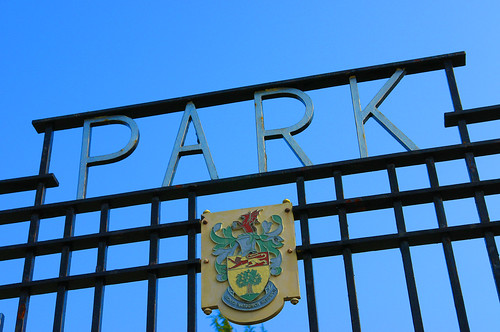
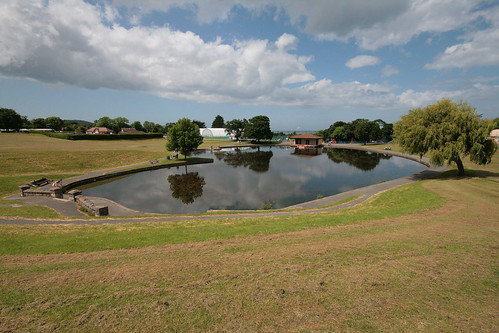


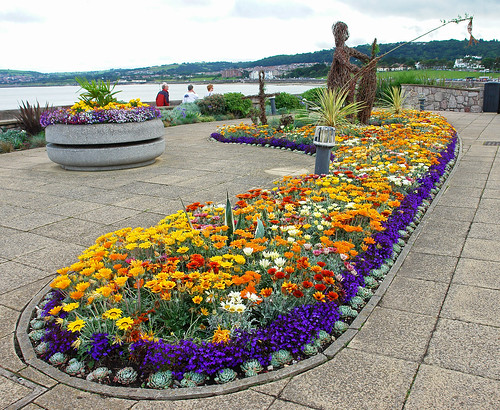

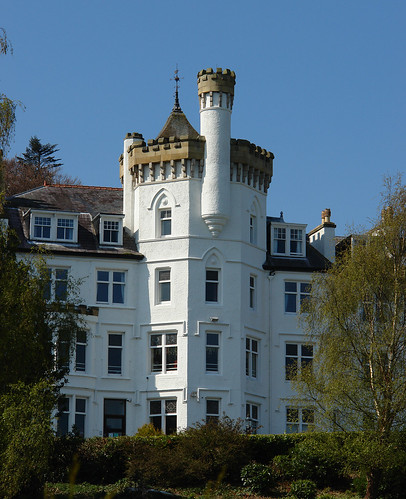





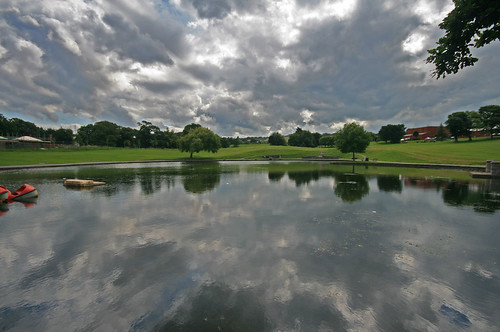
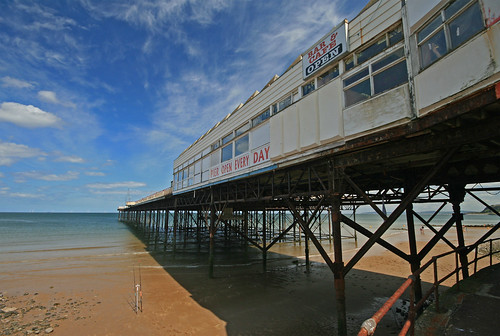

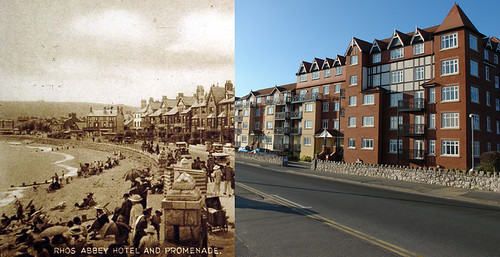

.jpeg)










